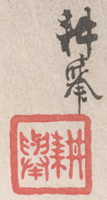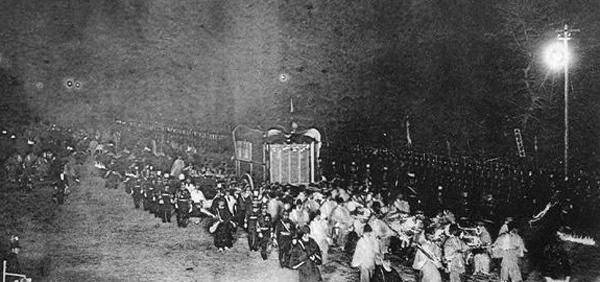About This Print
Source: Impressions of the Front: Woodcuts of the Sino-Japanese War, Okamoto, Shumpei, Philadelphia Museum of Art, 1983, p.31.The Empress Dowager Eishō (consort of Emperor Kōmei, 1831-1867), who was suffering with catarrhal pneumonia, died at on the evening of January 11, 1897 after a visit earlier in the day from Emperor Meiji and Empress Shōken. Her funeral was held on February 7. This print published on February 5, two days before the funeral, is an announcement of that event. The illustration was likely created from details provided by the Imperial Household Ministry. The black bordered inscription on the top of the center sheet starts with the words "Imperial Funeral Bulletin" 御大葬彙報, if I am translating it correctly.
For five days after the empress dowager’s death, courtbusiness was halted, and a period of mourning of a year was decreed, beginningon the day she died. Mourning clotheswould be worn at court, and other Japanese were to desist for thirty days fromsong, dance, and music. Flags would beflown with black streamers. For the nextfifteen days and on the days of the departure of the coffin and of the burial,criminals were not to be executed. The emperor and empress were unable to attend the funeral inKyōtobecause they both were ill, and it was feared that the exposure to winterweather might aggravate their illness.
The emperor commanded that henceforth the empress dowagerwould be known as Dowager Empress Eishō. This was a most unusual distinction, no doubt reflecting hisdevotion. There were scarcely anyprevious instances of an empress dowager or empress being given a posthumous name.
On February 2 Eishō coffin left the Aoyama Palace for the ŌmiyaGosho in Kyoto.
The funeral in Kyōto took place on February 7. The procession from the Ōmiya Gosho to theTsukinowayama Funeral Hall was long and impressive. The hearse was drawn by four oxen, and noblesand great men of state, all dressed in formal robes, walked behind it. Shintō priests carrying sakaki branches, brocade pennants, and halberds, or flaming torcheswalked to the left and right of the procession. A guard of honor from the Household Guards and Forth Division, alongwith naval personnel, accompanied the hearse. Field artillery of the Fourth Division fired salutes of minute guns, anda military band played “Kanashimi no kiwami” (Extremity of Grief), the dirgeplayed a funerals of senior members of the imperial family.
When the funeral procession reached the Yume no Ukihashi (FloatingBridge of Dreams), just before reaching the Sennyū-ji, the road became sonarrow that the coffin was transferred to a handcart. At ten that night the procession arrived atTsukinowayama, and at eleven a service was performed. The ceremony ended at twelve minutes after midnight on the eighth of February.
Perhaps the funeral’s most surprising feature was the absence ofBuddhist elements – no priests, no chanting of sutras, no incense. In the past, Shintō priests had beenunwilling to conduct funerals for fear of being infected the pollution of death,but ever since the Restoration, when Buddhism had fallen from favor, Shintōfuneral rites had been performed.
Print Details
| IHL Catalog | #1809 |
| Title or Description | Empress Dowager Eishō’s Imperial Funeral [this is an abbreviated translation of the title shown below, which talks about the Empress' coffin being transported from the Kyoto Ōmiya Palace to the Imperial Tomb] 京都大宮御所ヨリ陵月縄新御陵ヘ御送柩心圖 [as printed across the top of the center sheet] |
| Artist | Harada Kōkyo (1863-1925) |
| Signature |  |
| Seal | 耕舉 Kōkyo (see above) |
| Publication Date |  |
| Publisher |  firm name: Daikokuya Heiikichi [Marks ref. pub. 029; seal similar to 25-287] |
| Printer | |
| Impression | excellent |
| Colors | excellent |
| Condition | good - backed with heavy paper resulting in some wrinkling of the center and left sheets |
| Genre | ukiyo-e |
| Miscellaneous | |
| Format | vertical ōban triptych |
| H x W Paper | left sheet: 14 7/16 x 9 5/8 in. (36.7 x 24.4 cm) center and right sheets: 14 7/16 x 9 3/4 in. (36.7 x 24.8 cm) |
| Literature | |
| Collections This Print | National Diet Library Digital Collections Call Number 寄別7-2-2-6 |



